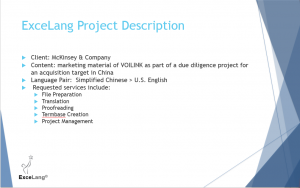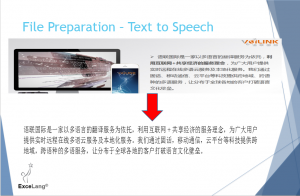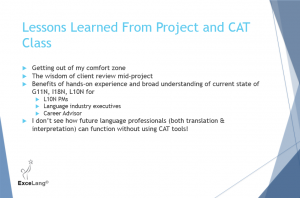When I was a translation student at MIIS in the late 80’s, the concept of “localization” as a service provided by language professionals never came up in our training – I am from the “pre-L10N” era. I did not come into contact with Computer Assisted Translation (CAT) until 2008 when my employer acquired a language services provider (LSP), Lingo Language Services, now named LanguageLine Translation Solutions (LLTS) in Portland, OR. LLTS’ core competency was and still is software localization. Having spent close to 20 years of my career in the LSP space focusing on remote interpretation, I found myself having to learn the new language of localization – file preparation, translation memory, translation management system, term base, and CAT. I also found myself managing as many engineers as I did project managers. For the next 6 years, I would work with the LLTS team on selection of tools and measurement of operating efficiency thanks to these tools, but I never had the time or mind share to actually learn and use them. This is why as soon as I could start taking classes as a MIIS employee, I chose to take Adam Wooten’s CAT class.
Though Adam Wooten’s class is named “Introduction to CAT”, its scope reaches beyond introduction to various CAT tools. It is an excellent introduction to language technology including CAT tools, machine translation & post-editing, controlled languages & authoring, interpretation technology, as well as numerous tips and insights regarding the business of translation.
Leveraging Hands-on Learning of CAT Tools
The aspect of the class that I was most interested in was the hands-on use of CAT tools. As Adam Wooten stated in the syllabus, this is about knowing “how to complete basic linguistics-focused functions in SDL Trados Studio 2015 including but not limited to translation memory creation, reuse of previous translations, terminology management, quality assurance, and translation editing according to best practices.” My objective was to learn the functionalities of a typical CAT tool, and thereby enable myself to learn other CAT tools with efficiency in the future. To my delight, our class had a “Learning How to Learn a CAT Tool” component. The learning objective was understanding “different components of SDL Trados Suite 2015 well enough to learn a completely new CAT tool on one’s own.” Equipped with my knowledge of Trados, I was able to learn memoQ effectively on my own as an assignment.
Machine Translation
The class on machine translation (MT) and post-editing was another fascinating experience. We reviewed and compared rule-based MT and statistical MT. Tanya Badeka and Juan Rowda, both of eBay, spoke to us on how eBay utilizes MT and post-editing to manage accuracy given the tremendous daily volume of work. The recent announcement of Google neutral machine translation (NMT) added to the depth of our discussions and debates in class. Our discussion on voice-to-voice machine interpretation heightened my awareness of the role voice recognition tools may play to expedite file preparation and translation output. In my final project, I saved file preparation time by 75% by using the speech to text input method rather than word processing in Chinese. I plan to experiment with using sight translation for production in the future.
Will MT Replace Human Translation?
MT is here to stay and scientists will continue to make improvements to it. Will MT replace translators? The answer is: It has already replaced some. According to Tanya Badeka and Juan Rowda, eBay’s in-house Linguists train MT systems rather than translate. Will MT replace translators completely? Not likely. MT scientists agree that there are still significant obstacles to be overcome and it is not for lack of available computing power. The upside is MT will create new positions. In a presentation at the American Translators Association in November, 2017, Jay Marciano listed the following positions that will be created thanks to AI:
– Translation Technology Expert
– Language Technology Analyst
– Language Process Analyst
– Machine Learning Supervisor
– Machine Learning Evaluator
– Language/Communication Analyst
– Semantic Analyst
– Translation Quality Assessor
– Data Collector
– Data Scientist
– Data Curator
– Terminologist
– Corpus Linguist
– Computational Linguist
– Premium Translators
– Premium Interpreter
Lessons Learned From Final Assignment
Our final project was to simulate a real-life translation/localization project. Here is my project overview:
Here is an example of the Chinese source text file provided by the client in PDF format which is not in a translatable file format in Trados and the MS Word file as the output from a voice to text exercise. What I estimated to be a 2-hour data entry exercise was completed in 30 minutes by using voice to text input method.
Here are my lessons learned.
Was it Worth the Investment of Time?
I have been asked: “You are not likely to be looking for a job as a translator or a localization project manager. Why are you investing the time to learn CAT?” First of all, I wanted to have hands-on CAT experience for translation projects in my own multilingual family, a goal that I expected to achieve and have achieved. As a Career Advisor, I am always thinking about how I can best position my students to employers. This class gave me more up-to-date and specific concepts and language to do so.
What I did not expect was how out of my comfort zone I was. On reflection, I realized that the excellent IT support I received at work and, indeed, at home has put me out of touch with basic trouble-shooting knowledge and skills. What used to be a blessing became a challenge when I had to handle tools hands-on. While my classmates were zipping through their class exercise, I was trying to find the file types. This class was a growth opportunity.
I cannot say enough about how wonderful our Professor Adam Wooten is. He is clearly a practitioner in the field day in and day out who is excellent at making his insights accessible to the students. His commitment to the students is commendable. He met with every one of his more than 100 students at the start of the semester and he had every team formally present their sales proposal to him for their final project. As a Career Advisor, I especially appreciate the career management tips that he so generously worked into his presentations. I am grateful for having the opportunity to take this class almost 30 years after I graduated from MIIS.
–Winnie Heh
Career & Academic Advisor
wheh@miis.edu





Thank you, Susan. I loved the CAT class. Hope you are doing well.
Love your article, Winnie.
I found it very timely and inspiring since I’m also struggling with the technology. A lot has happened since I used Trados 20 years ago.